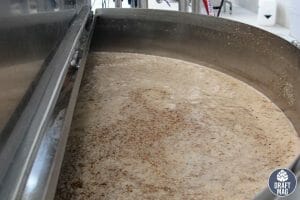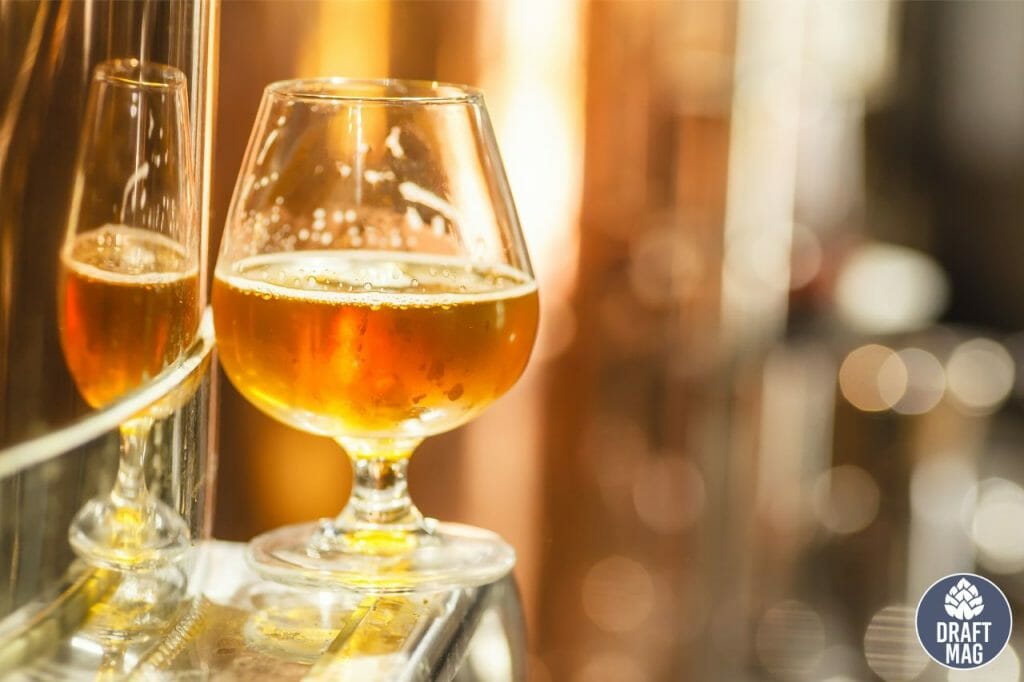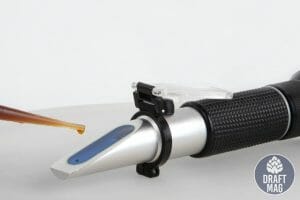What Is Lautering? A Beginner’s Guide To Acing the Brewing Process
 Lautering comes from the German word abläutern, which means to “rinse off,” and it is a three-step process in beer making. Beer enthusiasts and even beginners have probably heard this term being thrown around, so if you are unsure about what this really means then you’re in luck.
Lautering comes from the German word abläutern, which means to “rinse off,” and it is a three-step process in beer making. Beer enthusiasts and even beginners have probably heard this term being thrown around, so if you are unsure about what this really means then you’re in luck.
Our experts break down the complete process of lautering and explain how it really works, so keep reading our guide to find out everything you need to know about this topic!
What Is Lautering?
Lautering is a process in beer brewing that separates the mash and forms a clear liquid from which the beer is extracted. It separates the mash into a liquid containing the wort and the leftover grainy substance. It is a three-step process with mashing, varlauf, and sparging being the three primary steps.
Purpose
Lautering is a critical process in beer brewing as there is no separation of the beer liquid from the grains used. Brewers follow this lautering process in fermentation to infuse enough sugars into the wort to form food for the yeast that will create the alcohol.
The sugar is made by the controlled heat in the fermenter and the already present carbohydrate-heavy grains in the wort. This conversion of the grain into fermentable sugar particles is known as the mash formation stage. But the mashed substance is of hardly any use to the brewers as they can not themselves form beer. The sugary wort is extracted from this through the lautering process.
The beer brewing process is built on the foundation of lautering and helps in separating all the mashy grain from the actual alcohol. Lautering is important as it helps homebrewers get a consistent wort in different batches of beer and get a more homogenous wort than before.
The Lautering Process
There are three primary steps to the lautering process. However, some craft beer brewers skip a step or two to save time. But authentic and old-school brewers swear by the three-step lautering process called the mashout, the recirculation, and the sparging.
The steps might differ a little depending on the brewing process and recipe you follow. However, the basic structure remains the same for most beers.
– Equipment
To conduct the lautering process properly, you need to have specific equipment in hand in your beer brewing kit. Though technically the process can be done without tools, the process can become complicated and hard to master. So here is what you need:
- Two big vessels or even three, depending on the amount of mash and wort you are making.
- One large container to store the wort is needed. You need another container of the same size to store the hot sparge.
- A large strainer to help strain the wort if you are not using a dedicated lautering equipment kit.
- Other than this, if you have a proper lautering kit, it will come with a mash tun with a temperature regulator to control the temperature of the wort.
- A lautering kit equipment set will also have a hot liquor tank that will help store the sparge liquid.
- A professional kit also has a false bottom container which is insulated and helps separate the grain from the wort inside the container itself.
– Mashout
This is the last stage of the mashing process. The temperature of the mashed grain at this stage is maintained at 145 – 158 degrees Fahrenheit (63 – 70 degrees Celsius). However, some brewers prefer a 148 – 160 degrees Fahrenheit range. This set temperature range works well with the different enzymes to break down the carbohydrates or sugar particles in the wort.
After the temperature has been maintained at this controlled degree for about an hour, the temperature needs to be dialed up. This will warm the wort liquid and stop further breaking down of the good enzymes in the mashed liquid. Increasing the temperature locks the enzymes in and the complex carbohydrates stay. This step is more vital for any brewer trying to make a heavy-bodied beer as compared to a more dry and light-bodied one.
Then the temperature is increased to about 165 degrees Fahrenheit, or it can range between 160 – 170 degrees Fahrenheit, depending on the beer. This temperature is right above the threshold level of the mash enzymes to stop their actions and store the remaining carbohydrates.
Precaution
The mashout is considered crucial if there are less than three liters of water per kilogram of grains or if the said grain contains more than 25 percent of wheat or oats. So if you are using grains in these quantities, do not avoid this step. Also, if you plan to spend some extra time rinsing your mashed grains to extract the sugar wort, this step is a must for your brew.
– Recirculation
The Heat Exchange Recirculation Mash System (HERMS) or the Recirculating Infusion Mash System (RIMS) is used to avoid further scorching of grains due to the increased heat. This step means exactly what the name sounds like — the wort is again passed through the grain after the wort of the beer has been washed out from the mash tun.
This process works smoothly with a mash tun with a built-in false bottom. This vessel allows the collection of the grains while washing out the wort by passing it through an in-built strainer or a spigot. Commercial brewers have an automated system for the recirculation process. In a commercial lautering process, the wort is constantly passed through the bed of grains till the wort is totally clear and achieves clarity.
For home brewers, the recirculation process can work by adding a certain amount of hot boiling water to the wort and raising the temperature of the original mashout. Sometimes, this stage is hotter than normal — at 180 – 190 degrees Fahrenheit (82 – 88 degrees Celsius). A turbidimeter monitors this process to check the clarity of the wort and decide its next step.
Decocting
As a final step of this process, brewers can take out some of the mash from the whole, increase its temperature to a certain extent, and add it back to the original mash. This will help increase the temperature of the whole mash. This last bit of the process is known as mash decocting, where one-third of the mash is pulled out of the whole to increase the heat by boiling.
At this stage, the mash itself acts as a bed or filter to help in the filtration process of the wort. This stage will also help remove as much of the organic material from the wort as possible to start the next step or the sparging process.
– Verlauf
 Varlauf is a German term that means “to run-off.” In the beer brewing and lautering process, it refers to the first set of mash or lauter tun that comes out when the bottom drain is opened up. For those brewers who do all the grain brewing in coolers, the Varlauf stage comes to use. It is a simple process of setting the grain bed inside the vessel and getting a clarified wort liquid.
Varlauf is a German term that means “to run-off.” In the beer brewing and lautering process, it refers to the first set of mash or lauter tun that comes out when the bottom drain is opened up. For those brewers who do all the grain brewing in coolers, the Varlauf stage comes to use. It is a simple process of setting the grain bed inside the vessel and getting a clarified wort liquid.
Varlauf is another form of the recirculation process because the cloudy wort runs ahead of the actual clear wort brewers desire. So they keep recirculating back the wort through the bed of grains until they get a clear liquid to work with.
But you must also remember that the Varlauf process does not make the wort as clear as the recirculation process. It is advisable to use the recirculation process if you want extra clarity in your brewed beer.
Precaution
Homebrewers can choose to Varlauf with a simple pump to slowly and steadily pump back the unclear wort back into the mash grain bed until the liquid is clear. Or, if you plan to save money and not use a pump, then the wort can be collected in a vessel and repoured on top of the mash.
This pouring needs to happen very slowly to let the grains below have enough time to settle down and not over-compress them by pouring too fast.
– Sparging
Most new brewers confuse sparging and lautering and assume them to be synonymous. Sparging of various kinds is part of the actual three-step lautering process.
So what is sparging? When you have drained out the wort from the mash tun, you are left with a thick bed of grain, which will be found settled at the bottom of your vessel or inside the strainer you used to separate them.
Precaution
It is also essential for first-time brewers to remember that all beer lautering does not need the whole wort to be drained out from the bed of grains. You need to leave out some of the residual wort in the bed for a proper sparging process.
There are three common sparging methods: no sparge, batch sparge, and fly sparge.
No Sparging
The no sparging term refers to a single draining process of the wort through the grain along with the additional sparge water. This makes up for the total water needed to send into the boil kettle. The no sparge is a very convenient process that cuts down on the number of vessels used and reduces the overall cost of lautering.
No sparge also means no extra rinsing of the grains and is also known as the English sparging technique.
Batch Sparging
The Batch sparging technique involves draining the wort and periodically adding little portions of sparge water back into the grain bed. This sparge water is made over the stagnant bed of grains. The next batches of the wort made from this technique are not as strong as the original batch of wort.
In the olden days, brewers used this technique to make various beers of different intensities from the many different worts they obtained from each sparge. But in the present day, all of the different worts are combined together to form a single wort at the end.
This process can be a little crude and inefficient sometimes. However, brewers can master this technique with time. This can be done in double or triple batches, depending on the quantity of the grain bed, the recipe being followed, and the desired intensity of the beer.
Fly Sparging
Fly sparging refers to a continuous sparging technique. This is a slow process where the sparge water is slowly released from a hot liquid tank over the wort. This water then drains through the grain bed and for a long time — around 60 minutes or more. The wort is drained from the bottom of the vessel and results in a constant rise of sugar from top to bottom.
The fly sparging method is one of the most efficient and effective methods of sparging but needs a lot of equipment to make the process work properly. This needs a special kit called the sparge arm, which needs close and careful monitoring to get the best results.
Lauter Tun vs Mash Tun
A mash tun is a dedicated, heavy, and large vessel or a kettle used to hold the thick mash, while the lauter tun is a heavy-bottomed vessel with a fake bottom to filter out the grain of the bed from the rest of the wort.
A lautering tun is generally insulated but not heated, which might be missing in mash tuns. These two vessels do not necessarily have to be separate for homebrewers doing the lautering process on a small scale. But commercial brewers use a separate mash tun and lauter tun to streamline the brewing process.
– What Is a Mash Tun?
A mash tun is an insulated heavy vessel or chamber used in the first stage of the lautering process. This is the vessel used to mix the grains with the water and the mash is created to extract the wort from it.
Using the mash tun is important to maintain and regulate the temperature of the wort. If the temperature is not regulated at this stage with an insulated mash tun, the whole batch of beer can be spoiled.
– What Is a Lauter Tun?
A traditional lauter tun is a vessel used to separate and collect the wort. Previously, it followed a cruder method for collection, but the new equipment and vessel are more advanced. They come with their own filtration and fake bottom covering where the wort can be auto-filtered from the rest of the grain bed without further manual assistance.
A commercial lauter tun primarily consists of three things, a large vessel to contain the wort, a false bottom, and a manifold to help the recirculation of the wort through the grain bed. From this lauter tun, the wort is transferred to the kettle and the sparging water removes any remaining sugar to help in the collection process.
There is also a height adjusting machine above the large vessel to stop the bed of grains from collapsing on the wort and allowing a quick Varlauf. This also helps keep the clarity of the wort at the desired level to avoid any rework and wastage.
Do not get intimidated by the use of the huge vessels and the time and concentration needed to do the lautering. With practice, a good recipe and a proper guide can ease the process for you.
Duration
The brewing process of beer is generally very objective and the days are set by the recipe or beer type being brewed. But lautering is quite a subjective matter when it comes to time. Even if you use the same recipe for multiple batches of beer, you can change the timing of the lautering process just to get the different intensity of flavor and alcohol content.
So depending on your improvisation, the lautering process can take anywhere between 15 minutes to even 90 minutes. Many brewers chose to omit one of the three steps in mashout, recirculation and sparging.
Mashout and Recirculation
The mashout takes only about 10 minutes, while the recirculation time totally depends on the amount of clarity you want from your beer.
– Sparging
The sparging or the final step is sometimes omitted by some brewers to speed up the process. By skipping this stage, brewers also add some fining agent before bottling to get some clarity in their beer without any sparging.
Sparging is the most time-consuming of all the three steps and takes more than 30 – 40 minutes to complete. However, batch sparging is still considered a little faster than fly sparging. So, if you run short on time while brewing, you can choose to skip this one because the no sparges draining process takes only 10 – 15 minutes.
FAQs
– What Is the Difference Between Sparging and Lautering?
Sparging is the last step of the whole lautering process where hot water is run through the grain bed to extract usable liquid called wort, while lautering is what the whole process is called.
– What Is the Difference Between Mashing and Lautering?
Mashing is the process where grains like wheat, barley, rice, or oats are crushed and mashed up with water to extract soluble material from the mash, while lautering, on the other hand, is a three-step process, namely, the mashout, the recirculation, and the sparging.
The mash is then brewed and fermented to form different kinds of beers, and the lautering process is used to separate the liquid or the wort from the grainy portion of the mash. The raw wort is then used to convert it into beer.
– Should I Recirculate Wort?
Yes, recirculation is very vital to get a homogenous beer wort. It will also make your beer clearer and of better quality.
– Is Lautering Necessary?
Yes, if you are able to achieve lautering efficiency, it will help you avoid any astringent flavors and make all batches of your beers very consistent in taste and clarity.
Some people believe that lautering is simply washing the grains. However, this is far from the truth. No matter what type of grain you use in the brewing process of your beer, lautering is very important.
You can probably omit the sparging process and stick with the mashout and recirculation only. However, it is essential that you do at least the first two steps of the process.
Wrapping Up
If you are a homebrewer who is just starting out on the lautering journey, there is a lot for you to learn. Here is a quick look back at everything you need to know about lautering before starting the process.
- Lautering is the process of separating the usable wort and grain bed from the grain mash with a three-step process — namely, the mashout, recirculation, and sparging.
- There are lautering kits available in the market, including two to three large-sized vessels.
- The lauter tun is one of the large vessels used in this process. It comes with a fake bottom that acts as a sieve to collect and separate the grain bed from the rest of the usable wort.
- Sparging has three distinct divisions: no sparge, fly sparge, and batch sparge. Batch sparge among these is time-saving and gives the much-needed clear wort to start the fermentation process.
Though it might seem a little daunting, we have carefully curated this guide to simplify the process for you. So wait no more; start today and get the best homebrewed beer with lautering!






